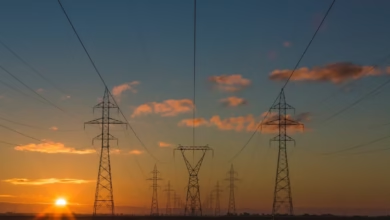Innovative Carbon Capture and Storage Technologies: Paving the Way for a Sustainable Energy Transition

As the world grapples with the urgent need to address climate change, Carbon Capture and Storage (CCS) technologies have emerged as a pivotal solution in the energy transition. With increasing reliance on fossil fuels, the urgent demand for innovative strategies to reduce carbon emissions has never been more critical. CCS not only offers a pathway to mitigate the impact of energy production on the environment but also plays a crucial role in integrating renewable energy sources, such as solar power, wind energy, and hydropower, into existing energy markets.
This article delves into the multifaceted role of carbon capture in achieving energy efficiency and security, exploring how advancements in this technology can bolster energy R&D and facilitate the transition to green energy. We will examine the integration of CCS with renewable energy, highlighting its potential to enhance energy storage and optimize smart grids. Furthermore, we will investigate the future of carbon capture technologies, assessing their implications for energy economics and the global energy landscape, including energy imports and exports. Join us as we navigate the innovations shaping the future of carbon capture and their vital contribution to combating climate change.
- 1. The Role of Carbon Capture in the Energy Transition: Innovations for Reducing Emissions
- 2. Integrating Carbon Capture and Storage with Renewable Energy: A Path to Energy Efficiency
- 3. Exploring the Future of Carbon Capture Technologies: Impact on Energy Markets and Climate Change Solutions
1. The Role of Carbon Capture in the Energy Transition: Innovations for Reducing Emissions
As the world grapples with the urgent need to address climate change, carbon capture and storage (CCS) technology stands out as a pivotal component in the energy transition. By capturing carbon dioxide emissions produced from the use of fossil fuels and other industrial processes, CCS plays a crucial role in reducing greenhouse gas emissions and facilitating a shift toward more sustainable energy systems.
Innovations in carbon capture technology have made it increasingly viable to integrate these solutions into various sectors of the energy market. For instance, advancements in direct air capture (DAC) have allowed for the extraction of carbon dioxide directly from the atmosphere, complementing traditional methods that focus on emissions from power plants. This innovation aligns with broader global energy trends that emphasize the need for energy efficiency and the decarbonization of energy systems.
In the context of energy storage and distribution, CCS can enhance the viability of renewable energy sources such as solar power and wind energy. By utilizing captured carbon to create hydrogen energy through processes like methane reforming, we can produce cleaner fuels that help diversify our energy portfolio. Furthermore, integrating CCS with thermal energy plants can significantly reduce their carbon footprint, making them more compatible with emerging energy policies that prioritize green energy solutions.
The role of CCS is also evident in the realm of energy R&D, where investments in carbon capture technologies are essential for developing more efficient systems that can operate alongside existing fossil fuel infrastructure. As energy markets evolve, the need for energy security becomes increasingly critical; CCS can help ensure that countries reliant on fossil fuels can transition more smoothly to greener energy sources without jeopardizing their energy exports or imports.
Moreover, smart grids and distributed energy systems can leverage CCS technologies to enhance energy transportation and storage capabilities. By capturing emissions from localized energy production, communities can contribute to a more resilient energy infrastructure that supports electric vehicles and other low-carbon technologies.
In summary, carbon capture and storage is an indispensable tool in the energy transition, fostering innovations that reduce emissions while enabling a diverse mix of energy sources, including nuclear energy, hydropower, and bioenergy. As we navigate the challenges of climate change, the integration of CCS into our energy systems will be key to achieving sustainable energy goals and ensuring a cleaner, more secure energy future.
2. Integrating Carbon Capture and Storage with Renewable Energy: A Path to Energy Efficiency
As the world grapples with the urgent need to combat climate change, integrating Carbon Capture and Storage (CCS) with renewable energy sources emerges as a crucial strategy for enhancing energy efficiency. This synergy not only addresses carbon emissions from fossil fuels but also supports the broader goals of the energy transition.
CCS technologies work by capturing carbon dioxide emissions produced from the use of fossil fuels in electricity generation and industrial processes, preventing them from entering the atmosphere. By coupling these technologies with renewable energy systems, such as solar power and wind energy, we create a comprehensive framework that maximizes the use of green energy while minimizing emissions.
Incorporating CCS into renewable energy frameworks can significantly enhance energy security and efficiency. For instance, when renewable sources like hydropower and bioenergy are used to power CCS facilities, the overall carbon footprint of both the energy production and the carbon capture process is reduced. This approach allows for the effective utilization of thermal energy and hydrogen energy, providing a balanced energy mix that can meet growing global energy demands.
Moreover, the integration of CCS with renewable energy can align with current energy policies aimed at fostering energy innovations and investment. As energy markets evolve, the emphasis on smart grids and distributed energy systems will enable better energy management, ensuring that captured carbon is effectively stored and utilized. This integration not only supports energy exports and imports but also positions countries to lead in energy R&D, fostering advancements that could reshape energy economics.
The transition to a low-carbon economy also hinges on the adoption of electric vehicles and energy storage solutions. By implementing CCS alongside renewable energy, we can create a sustainable infrastructure that supports the electrification of transportation while minimizing the reliance on fossil fuels. This holistic approach is crucial for achieving climate goals and addressing the pressing challenges posed by global energy trends.
In conclusion, the integration of Carbon Capture and Storage with renewable energy sources represents a vital pathway toward energy efficiency and sustainability. By leveraging innovations in energy technology and aligning with sound energy policy, we can ensure a resilient energy future that not only curtails carbon emissions but also supports economic growth and energy security.
3. Exploring the Future of Carbon Capture Technologies: Impact on Energy Markets and Climate Change Solutions
As we look toward the future of carbon capture technologies, the potential impact on energy markets and climate change solutions becomes increasingly significant. The urgency to address climate change has catalyzed a global energy transition, shifting focus from fossil fuels to renewable energy sources such as solar power, wind energy, and hydropower. Carbon capture and storage (CCS) technologies play a critical role in this transition by enabling the continued use of fossil fuels while mitigating their carbon emissions.
The integration of CCS into existing energy frameworks presents opportunities for enhanced energy security and energy efficiency. By capturing carbon dioxide emissions from thermal energy production, fossil fuel power plants can significantly reduce their environmental impact, making them more palatable within a broader energy policy aimed at reducing greenhouse gas emissions. This technology can also support the operation of smart grids, which optimize energy distribution and consumption, thus enhancing overall energy efficiency.
Moreover, carbon capture technologies can facilitate the growth of hydrogen energy as a key player in the energy markets. By capturing CO2 from hydrogen production processes, we can create a cleaner hydrogen fuel source, which is essential for decarbonizing various sectors, including transportation with electric vehicles and heavy industries. This synergy underscores the importance of energy R&D in developing innovative carbon capture solutions that align with global energy trends and economic objectives.
Energy investment in CCS technologies not only boosts the viability of renewable energy projects but also encourages the development of distributed energy systems. These systems can help balance energy imports and exports while ensuring that energy storage solutions are in place to manage supply and demand effectively. As we navigate the complexities of energy transportation and the evolving landscape of energy markets, it is crucial that policymakers prioritize energy innovations like carbon capture to advance climate change mitigation efforts.
In conclusion, the future of carbon capture technologies is intertwined with the broader themes of energy transition and sustainability. By integrating CCS into our energy systems, we can create a resilient energy economy that supports both current fossil fuel use and the shift toward greener energy solutions. This dual approach not only addresses immediate climate challenges but also paves the way for a more sustainable and secure energy future.
In conclusion, Carbon Capture and Storage (CCS) emerges as a pivotal technology in the global energy transition, offering innovative solutions to mitigate carbon emissions from fossil fuels while complementing renewable energy sources. As we explore the integration of CCS with various forms of energy, including nuclear energy, hydropower, and bioenergy, it becomes evident that this technology can significantly enhance energy efficiency and contribute to energy security. The future of carbon capture technologies promises to reshape energy markets, providing a pathway to a sustainable energy economy that prioritizes climate change solutions.
By aligning energy policy with investments in CCS, smart grids, and energy storage, we can foster a resilient infrastructure capable of supporting diverse energy imports and exports. The adoption of carbon capture will also play a crucial role in advancing global energy trends towards greener energy production, including solar power, wind energy, and hydrogen energy. As we navigate the complexities of energy economics and the ongoing challenges posed by climate change, embracing the full potential of CCS can drive innovation in energy R&D and facilitate a smoother transition to a cleaner, more sustainable energy landscape.
Ultimately, the successful implementation of carbon capture technologies will not only aid in reducing greenhouse gas emissions but will also fortify our energy transportation systems and bolster the growth of electric vehicles, thereby contributing to a healthier planet for future generations. As we move forward, it is essential for stakeholders across sectors to collaborate and invest in these transformative technologies to ensure a viable and environmentally responsible energy future.





